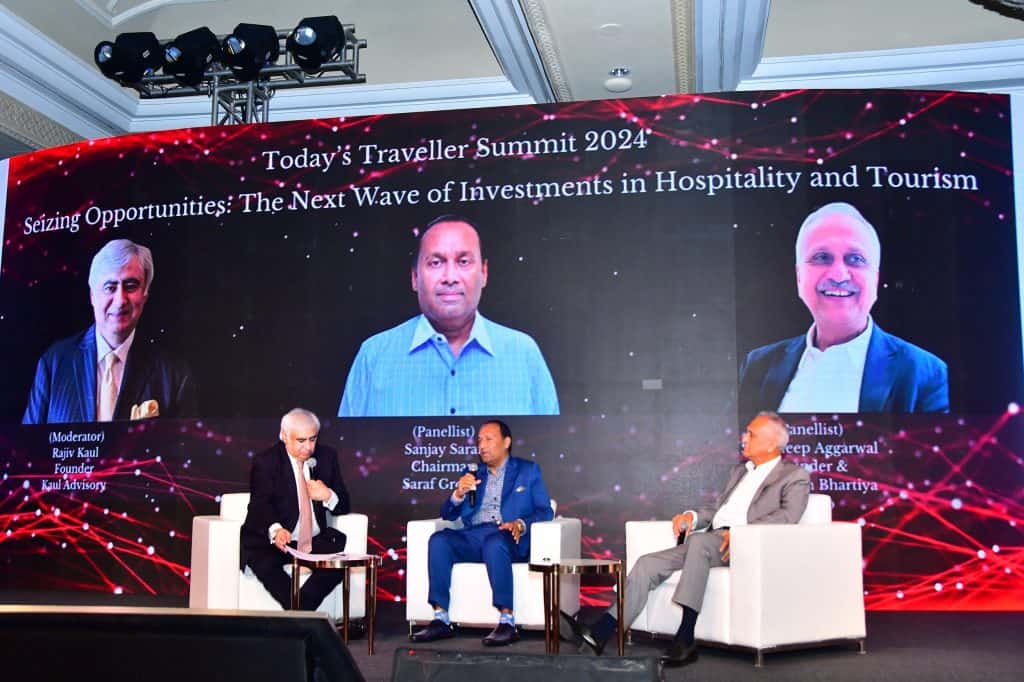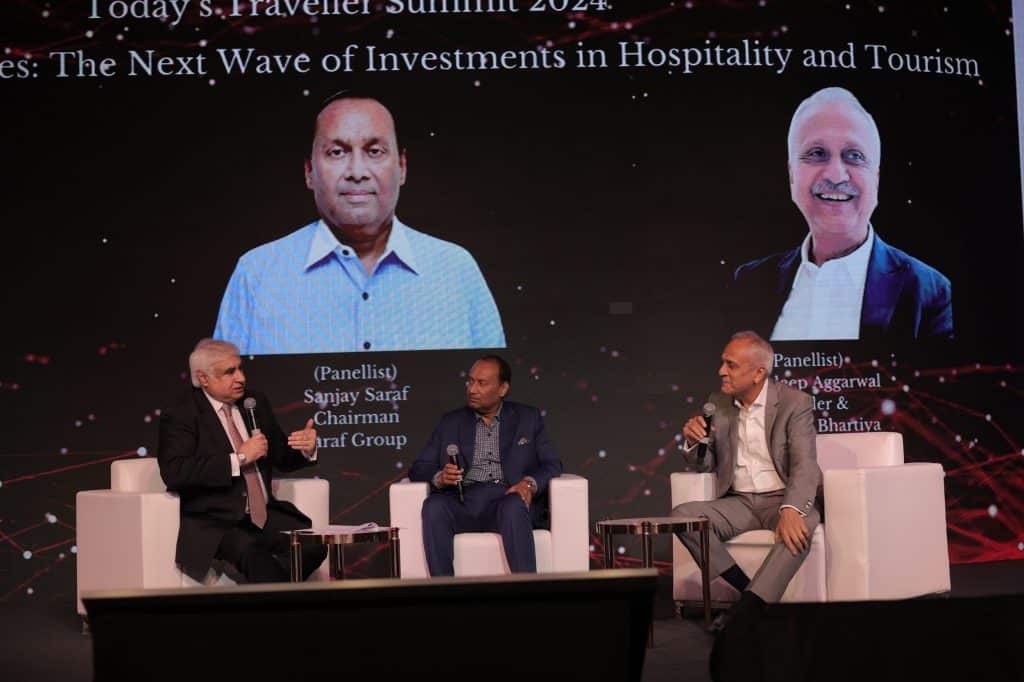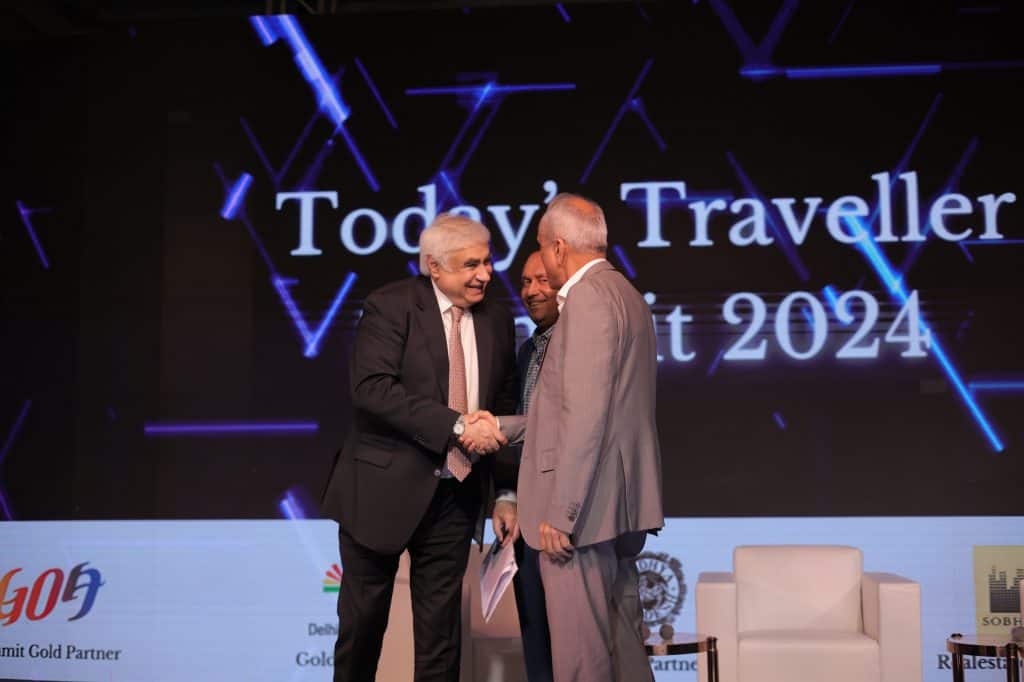Investments in Hospitality and Tourism took centre stage at the Today’s Traveller Summit and Awards event at the Taj Palace, New Delhi where hospitality industry visionaries gathered for an engaging and insightful panel discussion.

Moderated by Rajiv Kaul, Founder of Kaul Advisory, the session titled, ‘Seizing Opportunities: The Next Big Wave of Investments in Hospitality and Tourism’ at the Today’s Traveller Summit provided an in-depth look at the remarkable growth in India’s hospitality sector, especially the rise of resorts over city hotels. With insights from Snehdeep Aggarwal, Founder and Chairman of Bhartiya Group, and Sanjay Saraf, Chairman of Saraf Group, the conversation spanned key investment trends, the evolution of resorts, and the vast untapped potential within Indian tourism.
Sustaining the Upcycle: Building on Hospitality’s Record Growth
Rajiv Kaul set the stage with a reflection on India‘s hospitality industry’s current boom, highlighting record-breaking performance indicators. “These are good times for our industry,” Kaul began, noting the impressive results and valuations reported by hospitality companies. “We’ve waited for a long time for this upcycle. But what we want to do today is delve into how we make sure this upcycle is a long one.”
Kaul outlined key metrics driving this positive momentum: India’s hotel sector has added nearly 50,000 new keys in the past three years, bringing the total to 200,000. Additionally, transaction values in the sector have surged. “Last year, transaction values were under ₹3,000 crore. This year, we expect to see a 30% increase,” Kaul shared, underscoring the growing investor confidence in Indian hospitality.
Sanjay Saraf: Embracing Hospitality by Chance
A self-described “accidental hotelier,” Sanjay Saraf, Chairman of Saraf Group, recounted his entry into the hospitality world, shaped by a chance real estate investment during the pandemic. With his background in steel, generating a turnover of ₹5,000-10,000 crore, and a 5,000-acre tea estate, Saraf had not initially considered hotels. “We invested in a property in Kolkata, and from there, my interest in hospitality grew,” Saraf explained. “Then, during Covid, I wanted to escape Mumbai and be closer to Navi Mumbai. That’s when I saw the incredible potential in a piece of real estate near the new airport.”
Describing his Navi Mumbai project as a “game changer” for Mumbai, Saraf highlighted the strategic location’s ability to serve a burgeoning tourism sector. Proximity to the new airport is expected to position the property as a prime choice for both business and leisure travellers. Saraf’s journey reflects a growing trend of non-traditional players venturing into hospitality, recognizing the sector’s resilience and potential for future growth.
Snehdeep Aggarwal: The Visionary Defining Modern Resorts
Snehdeep Aggarwal, an entrepreneur with over 30 years of success in the fashion industry, shared his ambitious journey from European fashion to Indian real estate, culminating in the creation of Bhartiya City in Bangalore. “If I do something, it has to be big—it has to have scale,” he remarked. Aggarwal’s vision led to the development of a world-class hotel and convention centre in Bhartiya City, underscoring his commitment to creating transformative spaces that redefine the guest experience.
However, Aggarwal believes that most Indian “resorts” fall short of a true resort experience. He argued that many of these properties are essentially city hotels relocated to rural or suburban settings. “All so-called resorts in India are actually city hotels planted in suburban and rural areas,” he observed. “The whole focus is on the building—the opulent structure and the food offerings. But a true resort should focus on providing an experience.”
Aggarwal emphasized that as India’s economy grows, there is an increasing demand for meaningful experiences beyond material comforts. “In a country of 140 crore people, we are seeing rising disposable incomes, and with that, the desire to spend time nurturing our spirit,” he said. “We are a spiritual nation by birth, and as affluence grows, people will look to experience life beyond the basics. Resorts, therefore, represent an extraordinary opportunity to create spaces where people can reconnect with themselves and experience the beauty of life.”
The Untapped Potential of Resorts: Reimagining Tourism in India
Aggarwal pointed out that despite a population of 1.4 billion and significant growth in domestic tourism, India has yet to establish itself as a world-class resort destination. “We had about 10 million tourists in India last year, but how many of them were visiting our resorts?” he questioned, emphasizing that most international visitors stay in urban hotels rather than experiencing India’s natural landscapes. He believes this gap represents a “low-hanging fruit” that the industry can leverage by developing resorts focused on immersive, spirit-nourishing experiences.
“Our nation has unmatched potential to create beautiful destinations that rival the world’s best. Since the British left, we haven’t created any Shimlas or Mussoories,” he observed. While India has several religious pilgrimage centres, Aggarwal sees an opportunity to build leisure-focused resorts that emphasize nature, spirituality, and personal growth. “A resort should be a place where people can escape from the demands of everyday life and engage with their inner self.”
Investment Trends: Unlocking Underdeveloped Regions
Kaul then directed the conversation to future investment prospects, highlighting the underutilized regions of India that could offer unique tourist experiences while relieving congestion in traditional hubs. Saraf shared his optimism for these areas, describing them as fertile ground for growth. “There’s immense potential in developing regions that have, until now, been overlooked. With the right infrastructure and investment, these places could offer experiences just as compelling as popular destinations while easing the burden on traditional tourist sites,” Saraf noted.
Aggarwal echoed the need for sustainable development, advocating for a mindful approach that respects local culture and environments. “It’s about respecting the destination and creating something that adds value not only to the guests but also to the local community,” he explained. By balancing tourism growth with cultural preservation, India’s resorts can become destinations of spiritual and natural beauty, drawing international tourists while catering to the emerging domestic market.
Urban Luxury Resorts and Branded Residences: India’s Next Big Trend
The conversation went on to unfold yet another new trend. Sanjay Saraf, Chairman of Saraf Group, highlighted the promising yet untapped potential of urban luxury resorts and branded residences in India. With ambitious plans to develop a high-end urban resort in Navi Mumbai, Saraf shared his vision for redefining luxury in a growing market, addressing the motivations and market realities that shape this project. Kaul’s probing questions and Saraf’s insights shed light on the emerging trend of integrating branded residences with luxury hotels, a concept well-established globally but still novel in India.
Rajiv Kaul pointed out the bold nature of Saraf’s decision to invest in a luxury hotel in Navi Mumbai, a relatively untested market for high-end hospitality. “Investing in a luxury hotel in Navi Mumbai is a bold decision,” Kaul noted. “What has given you the confidence to move forward with this project, especially one of such stature in a new market? I understand you’re in talks with some of the most admired luxury brands.”
Saraf, acknowledging the inherent risk, explained his optimism rooted in Navi Mumbai’s ongoing transformation. “Bombay is transforming. We are having a new airport in Navi Mumbai, and with the Atal Setu and Worli connector coming, connectivity to the city center is set to improve drastically. You’ll be able to reach the new airport in just 30 minutes,” Saraf elaborated. He pointed out that Navi Mumbai’s defining advantage lies in its “luxury of space,” something increasingly rare in central Mumbai. “In my opinion, going forward, an urban luxury resort has a very bright future here,” he emphasized, highlighting his acquisition of strategically located land that he believes will soon be highly sought after.
Saraf also revealed his intention to introduce a new concept within his project—a combination of an urban luxury resort and branded villas for sale, representing a novel offering in the Indian market. “We are planning to develop an urban luxury resort along with branded villas for sale. This branded residence component is a concept not yet widely embraced in India, but I believe it could be a game-changer,” Saraf stated. He sees branded residences as an attractive addition to the resort, one that not only meets the rising demand for luxury but also diversifies the revenue model, offsetting the operational costs associated with hotel development.

Kaul agreed, noting the rarity of branded luxury residences in India, despite their success in international markets. “Unlike the rest of the world, India hasn’t seen many branded luxury residences. We have one at Bharatiya City, developed by Leela, but here we’re talking about high-value properties—$5 million to $10 million residences—that are yet to become common here. Globally, this concept has thrived. Why do you think India has been slower to embrace it, and what do you see as the future?” Kaul inquired.
The Rise of “Silent Luxury” in India’s Evolving Market
Saraf responded with an observation about the shift in Indian consumer preferences, especially following the pandemic. “After Covid, people are looking for larger spaces and seeking what I call ‘silent luxury.’ This concept of understated luxury is just starting to resonate with Indian consumers,” Saraf explained. He added that with increased international travel, Indians are more familiar with branded luxury residences in places like Phuket, Bali, and even emerging markets like Vietnam and Cambodia.
“India is now the fifth-largest economy in the world. The market is mature, and people have begun to appreciate and aspire to this lifestyle. Once people experience this branded luxury lifestyle, I believe they’ll be eager to adopt it here as well,” he asserted. While the cost of such developments initially deterred investors, Saraf believes that the evolving tastes of affluent Indians will drive demand for branded residences, easing the financial burden of developing hotel projects by combining them with luxury real estate.
Kaul highlighted the successful example of DLF, which has launched high-end villas in Goa, priced at around ₹60 crore, further demonstrating the shift toward branded lifestyle properties in India. “DLF’s development, Camellias, has set a high standard for lifestyle branding,” Kaul pointed out. “They’re leveraging this reputation to launch branded villas in Goa, a concept that has already generated significant interest.”
Saraf agreed, acknowledging DLF’s role in shaping a market for branded residences in India. “DLF’s brand Camellias has become synonymous with luxury. People from Delhi are shifting to Camellias because it’s more than a residence—it’s a lifestyle,” Saraf noted. By bringing this model to Goa, DLF is tapping into a rising demand for exclusive properties, designed not just as homes but as experiences. “In India, this concept is gaining traction, and I believe it will soon catch up in other parts of the country, including Navi Mumbai.”
Hospitality Valuations Soar: The Potential and Future of Indian Hotels
The discussion on hospitality investments took an intriguing turn as Rajiv Kaul questioned the unprecedented rise in hospitality valuations and room rates in India. With recent successful IPOs like those of Park, and Juniper drawing attention, Kaul explored the rationale behind valuations that have tripled since Covid. The panel offered insights into why investors are increasingly bullish on the sector, setting the stage for further growth.
Kaul addressed the issue, pointing out that hospitality profitability doubled but valuations soared by a factor of three. “With valuations this high, do you think they’re justified?” he asked Aggarwal, highlighting the influx of IPOs and investor enthusiasm.
Aggarwal, who has built a reputation for understanding long-term potential, affirmed the valuation surge, stating, “Valuations are about future potential. You’re looking at last year’s profit or current profit, and comparing that to today’s valuations. But these valuations are forward-looking. Why else would a loss-making company have a P/E of 200?” For Aggarwal, the growth of the Indian hotel industry is unmatched globally, with a future that savvy investors are keenly aware of. “Investors are intelligent, Rajiv, and they see that the sector’s true potential lies ahead. If Radisson is projected to have 500 hotels, each one of those will add immense value,” he explained, justifying the high valuations with investor confidence in future expansion.
Kaul echoed Aggarwal’s point, reminiscing about a time when the Indian hospitality sector was vastly undervalued. “For years, we were the most undervalued sector. We’d forgotten our own worth. For example, traditional companies like IHCL and EIH had shares that didn’t even reflect 30% of the replacement value of their assets,” he observed, noting that this era of low valuations had suppressed the true market potential of Indian hotels.
Today, however, there’s a shift, with investors recognizing the real estate and brand value embedded in the hospitality sector. “I’m happy to see investors realizing the immense value that exists in Indian hospitality,” Kaul added, capturing the sentiment of a sector finally receiving the attention it deserves.
Room Rates and Revenue: Tapping Into Untapped Potential
Shifting focus, Kaul directed a question to Sanjay Saraf regarding India’s room rates, which, despite being on the rise, remain relatively low compared to global standards. Saraf agreed, highlighting how India’s room rates, even at high-end properties like the Oberoi, are still affordable compared to international standards. “If you look at room rates around the world, similar properties fetch much higher prices. For instance, an Oberoi room here averages around $265 to $280 for the whole year, which is a fraction of what you’d pay for equivalent properties abroad,” Saraf remarked.
He emphasized that as inbound travel resumes and demand strengthens, Indian hotels will likely see a significant increase in room rates. “The Indian market is primed for an upswing in room prices as demand picks up,” Saraf stated, envisioning a scenario where Indian hospitality experiences a gradual elevation in pricing, aligning with global standards.
Adding to Saraf’s perspective, Aggarwal voiced his thoughts on India’s room rate landscape, reflecting on his recent travels to Europe. “I was in London recently, and you can’t find a decent room for less than a thousand pounds. Why, then, should luxury rooms in New Delhi or Mumbai still be priced at $250 or $300?” he asked rhetorically. For Aggarwal, the disparity between room rates and real estate prices in India’s major cities like Mumbai highlights a misalignment that the hospitality sector will need to address. He foresees that, eventually, room rates will rise to match the world-class real estate prices seen in India’s metropolitan markets.
The Transformation of Mumbai: Infrastructure and Opportunity
As the discussion turned toward Mumbai’s evolving infrastructure, Kaul pointed to the city’s impressive upgrades, asking Saraf about his outlook on how these changes could transform the city and, by extension, its hospitality landscape. Saraf responded with palpable enthusiasm about the potential of Navi Mumbai, specifically its new international airport.
Saraf described Navi Mumbai as a future hub for luxury developments, where the abundance of space enables the creation of expansive, well-planned projects. “Mumbai has always faced a constraint of space, but Navi Mumbai has room for growth. It’s going to be like Gurgaon was 30 years ago—a blank slate, but this time, better planned from the outset,” he shared. With the government’s commitment to the region’s development, Saraf expressed confidence that Navi Mumbai will emerge as a game-changer, akin to a new city built to meet modern standards.
New Horizons for Hospitality
As the panel came to a close, Rajiv Kaul provided a thought-provoking summation, encapsulating the key insights shared by the panel on the future trajectory of Indian hospitality. With the sector experiencing record-breaking growth and valuations, Kaul emphasized the exciting shifts within the industry that go beyond traditional hotel investments, heralding a “new wave” marked by experiential resorts, branded residences, and diversified investor interest. This evolution, as Kaul pointed out, reflects a broader transformation driven by India’s increasing affluence and evolving consumer preferences.

Kaul reiterated this point, noting that experiential resorts cater to an increasingly affluent population that seeks not only comfort but also deeper, meaningful experiences. “We’re talking about the top of the pyramid, that aspirational experience,” he said, underlining that resorts designed with this purpose will attract both high-end domestic travellers and international visitors seeking an authentic connection to India’s heritage.
Shifting to another major trend, Kaul turned to the growing demand for branded residences. “Branded residences are going to be a huge opportunity. People don’t just want real estate anymore—they want a lifestyle,” Kaul explained. This shift, Kaul noted, aligns with the increasing affluence in India, where luxury buyers value the prestige and convenience that branded residences provide.
“Forty years ago, hotels were primarily built by hotel companies. Then came the real estate developers, who saw the potential to incorporate hotels into their portfolios alongside retail and commercial projects. Now, HNIs and private equity players have entered the scene, recognizing the value in this evolving lifestyle sector,” he elaborated.
The involvement of private equity and high-net-worth individuals (HNIs) has introduced a new level of sophistication and resources to Indian hospitality. Kaul reflected on how this shift has impacted the industry’s landscape. “The private equity guys saw the gaps and seized opportunities, and now HNIs have come to the party,” he noted, observing that these investors bring both capital and demand for innovative products. This investment influx allows for the development of properties that are not only profitable but also serve as lifestyle assets for owners.
Kaul underscored how these investments are propelling the industry beyond conventional models, creating a dynamic where both the operator and the owner benefit from a hybrid model that includes high-end hotels, branded residences, and experiential resorts. “With such serious action on the horizon, the landscape of Indian hospitality is set to evolve in ways we haven’t seen before,” he added, stressing that this era of investment diversification is a positive development for the industry’s long-term sustainability.
As the session concluded, Kaul left the audience with a vision of a rapidly transforming Indian hospitality industry, driven by new product types, increased affluence, and diverse investor interest. With key players like Snehdeep Aggarwal and Sanjay Saraf championing these concepts, the future of Indian hospitality appears poised for a period of growth that transcends traditional hotel operations.
Read More: News



